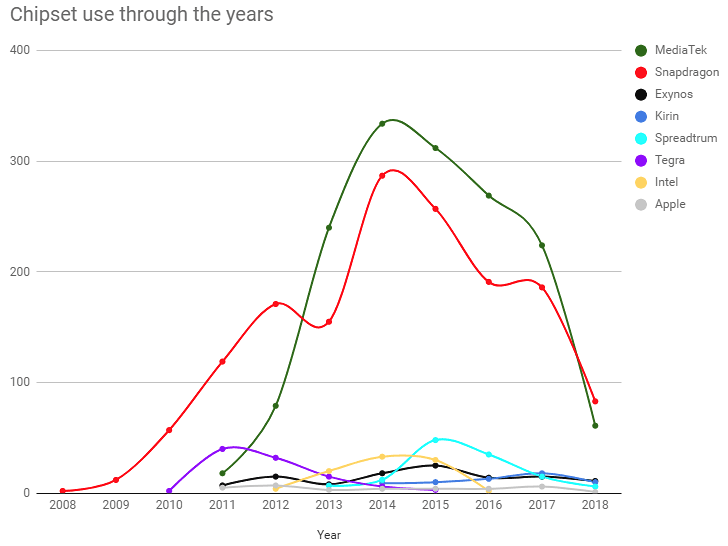Counterclockwise: the popularity of chipsets through the years
Counterclockwise: the popularity of chipsets through the years
10 JUNE 2018

During the 70s and 80s there was an explosion of processor architectures, many of which found their way to smartphone chipsets. ARM, which traces its roots back to the 1981 BBC Micro, clearly won the game but it faced competition in the past. Intel (and AMD’s) x86/x64 rule the desktop and server market, but they briefly existed on mobile too.
There’s a lot of stories to tell here. For example, Qualcomm’s Adreno GPUs come from ATI’s mobile Radeon efforts (it’s an anagram). AMD decided against supplying phone chips so sold the division. Do you think AMD execs regret that decision?
Rival GPU maker Nvidia tried to bring Tegra chipsets with GeForce graphics to mobile and some of the earliest dual and quad-core phones were Tegra-powered. Now Tegra mostly exists in car computer systems (leveraging the GPU for machine learning and self driving).
The MIPS architecture, a rival to ARM, was supported by Android and was acquired by Imagination, which is best known for the PowerVR GPUs. Among those were the ones in iPhones and iPads, which were among the most powerful. Then Apple decided to make in-house GPUs and put Imagination in a tough spot and it had to put MIPS up for sale. Even ARM itself is now part of SoftBank.
Yes, Apple now has in-house chipsets with in-house CPUs and in-house GPUs. Few other companies can claim the same and fewer still have any success with those. In fact, when it comes to smartphones, no other company can claim quite the same level of independence.
Samsung’s Exynos chipsets include custom CPU designs, but they use ARM’s Mali graphics. Qualcomm has its own GPU, but these days its CPU cores are derived from ARM’s Cortex-A series. Huawei’s Kirin line as well as MediaTek’s chips stick to ARM designs exclusively.
There’s an interesting dynamic between chipset makers and phone makers. Samsung and Huawei do both, but technically each part is handled by a separate company. So, Samsung occasionally sells an Exynos to other brands, though it’s mostly used in Galaxy phones. The same goes for Huawei.
Then Qualcomm and MediaTek do not make their own phones, but are hugely popular. In fact, the number of phones and tablets powered by a MediaTek chip is much higher than the Exynos-powered devices.
We counted the number of models (phones and tablets) that use a particular chipset. Some numbers are self-limited – Apple launches only so many devices a year and it sure won’t sell its chipsets to other companies. Other chipsets just died off – e.g. Nvidia’s Tegra and Intel’s Atom.

Note: we counted phones that have models with different chipsets once for each chip they use.
Having a choice of chipset is important as we all saw with Qualcomm’s Snapdragon 810 blunder. We suspect that this motivated many companies to try and build their own chipsets to gain some independence (Xiaomi is a recent example).
Even Nvidia had a custom design (the Denver core), but that was used only once – in the Nexus 9. Again, the GPU maker is too focused on the lucrative machine learning and car self-driving tech to care for the thin margins on mobile.
And AMD is riding high after its Ryzen architecture finally rose up to Intel’s Core. With both CPU and GPU designs, will AMD jump on mobile? It has some experience with ARM chips or it could go the x86 route. Though perhaps Intel’s experience in mobile is enough to keep AMD focused on PC and server tech.
We expect to see more major smartphone manufacturers create in-house chipsets. But we think that they will mostly be variations on Cortex and Mali. The future may surprise us, however. Google designed a custom core for the cameras on Pixel phones, Huawei has the NPU for machine learning and so on. Maybe the focus on general purpose CPUs and GPUs is not the way forward, but instead custom, specialized cores.




Comments
Post a Comment